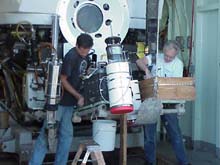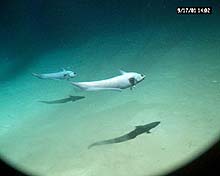The Deep Water Dumpsite
September 17, 2001
Holly Richardson Donovan, Teacher
Robert Hunter School, Flemington, New Jersey
"It's always ourselves we find in the sea."
-- e.e. cummings
Despite winds hovering in the range of 20-23 knots and 20-ft wave swells, the decision was made to launch the Alvin deep submergence vehicle (DSV). At 9:15 am, most of us headed to the stern to watch. Some of us climbed to a position on a small observation deck overlooking the aft section of the ship. The morning sun shimmering brightly off the sea to the east was almost blinding. It glinted off the shiny white exterior of Alvin as the submersible sat waiting under the towering blue steel A-frame of the hydraulic lift, ready to be lowered into the sea.
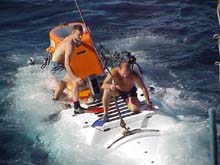
Launch-and-recovery swimmers Paul Vinitsky and Brian Leach release Alvin into the ocean. Click image for larger view.
Today's pilot, Dudley Foster, boarded Alvin first, climbing up the lift ladder and disappearing down through the orange turret (the "sail") on top. Minutes later, scientists Rose Petrecca, from Rutgers University, and Mike Bothner, from the U.S. Geological Survey, followed, stopping to wave to the assembled group before vanishing into the submersible.
Two divers, in their bathing trunks and flippers, perched on top of the submersible, working with the engineer to secure the hatch and ready the lift. Meanwhile, off the starboard side, the pontoon dingy was launched to retrieve the divers from the sea after the submersible was released and under its own power. The dingy motored around to the Atlantis' stern and waited a couple of hundred meters away, bobbing up and down in the swells.
With a rumbling screech, the lift hoisted the Alvin until it dangled in midair above the stern. As the divers gave a thumbs up, the lift extended out over the water and gently lowered the sub into the ocean. Alvin hovered for a few minutes, partially submerged on the surface and buffeted by the waves. The divers, after making a final check, swam off to the awaiting dingy. Then, with a couple of small spurts of vapor from the top, the submersible sank out of view to begin its voyage down 2,600 m to the Deep Water Dumpsite (DWD) (also known as the 106-mile Dumpsite).
After more than 6 hrs in "inner space," the Allvin resurfaced off Atlantis' bow and was hoisted back on board. The scientists emerged brimming with stories of all they had seen, and what they had managed to collect as they explored the site. Mike Bothner described the topography in this region of the continental rise as "very dramatic." One would expect it to be flat, he said, but in fact, it was "like a gentle slope on a treeless terrain, lined by ridges and valleys, and covered with powdery, snowlike layers of fine sediment." They saw many burrows in the sediment showing evidence of animal life. They collected several biological specimens including a brilliant orange sea star, a few small, orange brittle stars, white sea urchins, and a chubby, translucent violet, foot-long sea cucumber in perfect condition. Many rattail fish had approached the submersible, seeming to stare at it curiously with their large eyes. Though for years the dumpsite had been a repository for millions of tons of human waste, strikingly, the only visible evidence of humanity was a string attached to a lone, spent balloon lying on the ocean floor. As Alvin's video camera was not working today, we will have to create our own visual images of this site from the scientists' descriptions and memories.
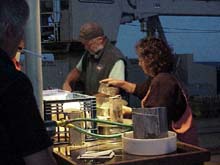
Benthic ecologists Rose Petrecca and C. Hovey Cliford seive for small organisms found in Alvin's box-core samples of the ocean floor. Click image for larger view.
TAs soon as Alvin had slowly glided along its track back into the hangar to be cleaned, checked, and prepared for another dive, we huddled around the sample baskets. The geological oceanographers took their core samples to one lab to tightly seal and catalog them. The chemical oceanographer and a microbiologist loaded their water samples into crates and took them to another lab. Some of these samples would be tested almost immediately for methane traces and other chemical indicators of possible seep or plume activity in the region, while others would be examined later for bacterial content. The benthic ecologists remained on the stern in their rubber boots and colorful rubber overalls with hoses running and mud everywhere. They then systematically sieved through the box- core samples to isolate any small organisms. The sorted samples were preserved in carefully labeled jars. The work of examining and drawing conclusions from the samples and the data they generate will occupy the scientists for months and years to come. Tomorrow, another dive site will yield its clues about conditions and life in the deep ocean.
(top)
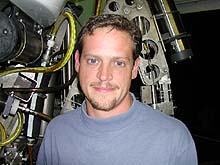
Gavin Eppard, mechanical technician of the Alvin Group on the R/V Atlantis.
Interview with Gavin Eppard
Mechanical Technician, Alvin Group, R/V Atlantis
Ocean Explorer Group: What are your duties aboard the R/V Atlantis?
Gavin Eppard: On the ship, I'm responsible for mechanical maintenance on the DSV Alvin and for making the pre- and postdive checks on the submersible. I'm also a launch-and- recovery swimmer. After the Alvin is deployed, I ride the sub out on the launch boat with another swimmer while maintaining communications with the sub pilot using a sound-powered phone system. Before and after the dive, I tend to the safety lines of the science basket, secure samples, and assist the pilot. After the dive, we escort the submersible back to the bow of the ship from the launch. When needed, I'm also qualified to drive the A-frame, which is used to launch and recover the submersible on the bow of the ship. There is a control panel to operate the lines, which use hydraulics.
Ocean Explorer Group: What type of background do you have and how did you come to work for the Alvin Group?
Gavin Eppard: My background consists of 10 years' experience as a dive master and rescue diver. Prior to my position on the R/V Atlantis, I had a digital imaging and graphic- arts company. Then I free-lanced in the field of multimedia. While exploring my career opportunities and interests, I enrolled in the MATE Program, which stands for Marine Advanced Technology Education Center. I took classes involving technical computer programs and submersible technology and was part of a team of 12 technicians who actually built a remotely operated vehicle, or ROV. A fellow student and I were responsible for the video portion. We had a budget of $1,000 to plan and build the ROV. My team successfully constructed the vehicle for approximately $750. I also did internships on a vessel run by Duke University and on a geological coring ship through the Ocean Drilling Program at Texas A&M University. I obtained my position with the Alvin Group on the R/V Atlantis in April 2000. For my next career move, I want to pilot the DSV Alvin.
Interview by Caren A.D. Menard of the Ocean Explorer Team.
Sign up for the Ocean Explorer E-mail Update List.

































